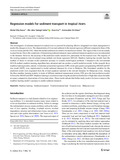| dc.contributor.author | Harun, M.A. | |
| dc.contributor.author | Safari, M.J.S. | |
| dc.contributor.author | Gul, E. | |
| dc.contributor.author | Ghani, A.A. | |
| dc.date.accessioned | 2021-05-27T11:19:21Z | |
| dc.date.available | 2021-05-27T11:19:21Z | |
| dc.date.issued | 2021-05 | |
| dc.identifier.uri | https://link.springer.com/content/pdf/10.1007/s11356-021-14479-0.pdf | en_US |
| dc.identifier.uri | https://dspace.yasar.edu.tr/xmlui/handle/20.500.12742/11233 | |
| dc.description.abstract | The investigation of sediment transport in tropical rivers is essential for planning effective integrated river basin management to
predict the changes in rivers. The characteristics of rivers and sediment in the tropical region are different compared to those of the
rivers in Europe and the USA, where the median sediment size tends to be much more refined. The origins of the rivers are mainly
tropical forests. Due to the complexity of determining sediment transport, many sediment transport equations were recommended
in the literature. However, the accuracy of the prediction results remains low, particularly for the tropical rivers. The majority of
the existing equations were developed using multiple non-linear regression (MNLR). Machine learning has recently been the
method of choice to increase model prediction accuracy in complex hydrological problems. Compared to the conventional
MNLR method, machine learning algorithms have advanced and can produce a useful prediction model. In this research, three
machine learning models, namely evolutionary polynomial regression (EPR), multi-gene genetic programming (MGGP) and M5
tree model (M5P), were implemented to model sediment transport for rivers in Malaysia. The formulated variables for the
prediction model were originated from the revised equations reported in the relevant literature for Malaysian rivers. Among
the three machine learning models, in terms of different statistical measurement criteria, EPR gives the best prediction model,
followed by MGGP and M5P. Machine learning is excellent at improving the prediction distribution of high data values but lacks
accuracy compared to observations of lower data values. These results indicate that further study needs to be done to improve the
machine learning model’s accuracy to predict sediment transport. | en_US |
| dc.language.iso | English | en_US |
| dc.publisher | Springer | en_US |
| dc.rights | info:eu-repo/semantics/openAccess | en_US |
| dc.subject | Machine learning | en_US |
| dc.subject | Sediment transport | en_US |
| dc.subject | Total bed material load | en_US |
| dc.subject | Tropical rivers | en_US |
| dc.subject | Malaysia rivers | en_US |
| dc.title | Regression models for sediment transport in tropical rivers | en_US |
| dc.type | Article | en_US |
| dc.relation.journal | Environmental Science and Pollution Research | en_US |
| dc.identifier.doi | 10.1007/s11356-021-14479-0 | en_US |
| dc.contributor.department | Faculty of Engineering | en_US |
| dc.contributor.yasarauthor | 0000-0003-0559-5261: Mir Jafar Sadegh Safari | en_US |















